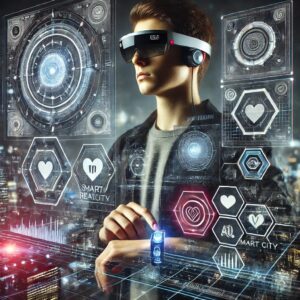
In recent years, the rapid evolution of digital transformation and wearable technologies has fundamentally reshaped industries across the globe. Businesses are embracing innovative tools to optimize operations, enhance customer experience, and provide personalized services. Wearable technology, in particular, is transforming the way we interact with the world, merging the digital and physical realms. This article explores the current trends in digital transformation, the impact of wearable technology, and how they work together to create a more connected and efficient world.
What is Digital Transformation?
Digital transformation refers to the integration of digital technologies into all areas of business operations, leading to fundamental changes in how businesses operate and deliver value to customers. It’s more than just upgrading technology; it’s about fostering a cultural shift that embraces innovation, enhances collaboration, and optimizes processes. From cloud computing and artificial intelligence to data analytics and automation, digital transformation enables companies to make faster, more informed decisions while increasing operational efficiency.
One of the key drivers of digital transformation is the Internet of Things (IoT). IoT connects everyday devices to the internet, enabling them to collect and exchange data. Businesses can leverage IoT for predictive maintenance, enhanced supply chain management, and even customer behavior analysis. As IoT continues to evolve, it is expected to create even more opportunities for innovation in various sectors, including healthcare, manufacturing, and retail.
The Rise of Wearable Technologies
Wearable technology refers to electronic devices designed to be worn on the body, often integrated into clothing, accessories, or embedded in the user’s environment. These devices monitor and collect data about the wearer’s health, environment, and behavior. Popular examples include smartwatches, fitness trackers, and smart glasses. These devices are revolutionizing personal wellness, healthcare, and even entertainment.
- Source: Wearable Tech Trends – TechRadar
Smartwatches, such as the Apple Watch or Fitbit, are among the most widely adopted wearable devices, providing users with real-time health metrics such as heart rate, sleep patterns, and physical activity levels. These devices also allow for seamless connectivity with smartphones, enabling users to receive notifications, make calls, and track important metrics throughout the day.
The Intersection of Digital Transformation and Wearable Technologies
The convergence of digital transformation and wearable technology is creating a more interconnected and data-driven world. With the vast amount of data generated by wearable devices, businesses can gain valuable insights into customer preferences, health trends, and lifestyle choices. This data can then be analyzed and leveraged to deliver personalized experiences, tailored recommendations, and even predictive health analytics.
For example, healthcare providers are using wearable devices to monitor patients’ health in real time, allowing for more accurate diagnosis and proactive treatment. Hospitals can use data collected from wearable health devices to track patients’ recovery, monitor chronic conditions, and provide more efficient care. As wearable technology continues to evolve, its potential for revolutionizing healthcare is immense, offering more precise treatments and improving patient outcomes.
In the retail industry, wearable technology can help businesses better understand customer behavior and preferences. Smart glasses and augmented reality (AR) devices can enhance the shopping experience by allowing customers to virtually try on clothes, view product information, and receive personalized discounts. Retailers can use data from wearables to offer personalized promotions and increase customer satisfaction.

The Benefits of Digital Transformation and Wearables
The integration of wearable technologies within the broader scope of digital transformation offers several key benefits, including:
-
Increased Efficiency and Productivity: Wearable devices can help employees in various industries become more productive. For example, factory workers equipped with smart glasses can receive real-time instructions and access important data hands-free, leading to more efficient operations.
-
Improved Health and Well-being: Wearables have the potential to improve health outcomes by tracking vital signs and encouraging healthier lifestyle choices. Fitness trackers motivate users to exercise, monitor their nutrition, and even detect early signs of potential health issues.
-
Personalization: Digital transformation and wearables enable businesses to create more personalized experiences for their customers. Whether it’s personalized fitness plans, tailored shopping recommendations, or custom healthcare solutions, businesses can use the data from wearables to cater to individual needs.
-
Better Decision-Making: With real-time data and insights from wearables, businesses can make more informed decisions. Whether it’s analyzing market trends or monitoring employee performance, data-driven decision-making is now more accurate than ever.
Challenges and Considerations
While the potential for digital transformation and wearable technologies is vast, there are several challenges and considerations that must be addressed:
-
Privacy and Security Concerns: With the continuous collection of personal data from wearable devices, there is an increased risk of data breaches and privacy violations. Companies must implement strong data protection measures to ensure that user information remains secure.
-
Technology Integration: Integrating wearable technology into existing systems can be complex. Companies must ensure that wearables are compatible with other digital tools and platforms to achieve seamless functionality.
-
User Adoption: For wearable technologies to reach their full potential, they must be adopted by a large user base. This requires careful consideration of user experience, affordability, and accessibility.
The Future of Digital Transformation and Wearable Technologies
As digital transformation continues to reshape industries, the role of wearable technologies will become even more significant. In the coming years, we can expect to see the integration of 5G networks, which will provide faster connectivity and enable even more advanced wearables with enhanced functionalities. Artificial intelligence (AI) and machine learning will also play a key role in analyzing the vast amounts of data generated by wearables, leading to more personalized and efficient experiences for users.
In healthcare, wearables may evolve to monitor specific conditions such as diabetes or heart disease, providing real-time data that can be used for personalized treatment plans. In retail, we may see even more immersive shopping experiences with the use of virtual reality (VR) and AR technologies.
The future is bright for digital transformation and wearable technologies. As these technologies evolve and intersect, they will continue to shape the way we live, work, and interact with the world around us.
